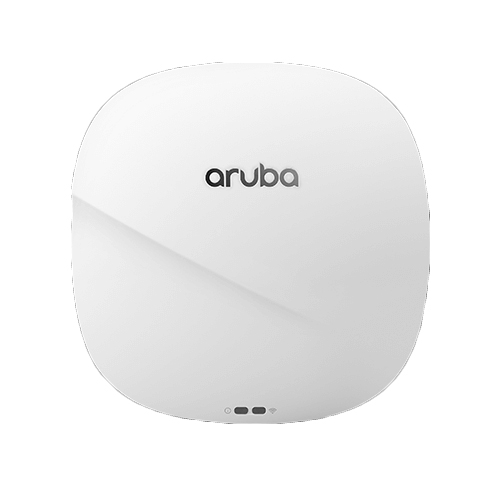Aruba 344 Access Point
| Data Transfer Rate | 3Gbps |
| MIMO | 4x4:4 |
| Power | PoE AC |
| Radio Band | Dual |
| Wireless Type | 802.11 a/b/g/n/ac |
| Environment | Indoor |
Product Highlights
Aruba 344, 2.40 GHz 5 GHz, 802.11ac, 3 Gbit/s, MIMO
Aruba 340 Series Access Point
The Aruba 340 series access points provide the fastest 802.11ac gigabit data speeds and superb user experience for mobile devices and applications in a digital workplace.
Designed with an integrated, 802.3bz compliant, HPE SmartRate multi-gig Ethernet port to eliminate wired bottlenecks, these APs offer unmatched wireless performance and capacity.
The unique and flexible dual-5GHz architecture of the 340 series offers a way to boost 5GHz capacity where needed.
Benefits
Unified AP – deploy with or without controller
- The 340 Series APs can be deployed in either controller- based (ArubaOS) or controllerless (InstantOS) deployment mode
Dual Radio 4x4 802.11ac access point with Multi-User MIMO (wave 2)
- Supports up to 2,166 Mbps per radio in the 5 GHz band (with 4SS/VHT80 or 2SS/VHT160 clients) and up to 800 Mbps in the 2.4 GHz band (with 4SS/VHT40 clients)
- Antenna polarization diversity (fixed) for optimized RF performance
Optional dual-5 GHz mode supported, where the 2.4 GHz radio is converted to a second 5 GHz radio
- Both 5 GHz radios providing full coverage, doubling the performance and capacity
- Unlike competitive solutions, the 340 Series is designed to isolate the two 5 GHz transmitters for higher performance
- Conversion can be manual/fixed, or automatic and dynamic (software controlled, under-the hood), based on system-wide capacity and load in both bands
HPE SmartRate uplink Ethernet port (E0)
- Supports up to 2.5 Gbps with NBase-T and IEEE 802.3bz Ethernet compatibility
- Backwards compatible with 100/1000Base-T
Hitless PoE failover between both Ethernet ports
Built-in Bluetooth Low-Energy (BLE) radio
- Enables location-based services with BLE-enabled mobile devices receiving signals from multiple Aruba Beacons at the same time
- Enables asset tracking when used with Aruba Asset Tags
Advanced Cellular Coexistence (ACC)
- Minimizes interference from 3G/4G cellular networks, distributed antenna systems and commercial small cell/femtocell equipment
Quality of service for unified communications applications
- Supports priority handling and policy enforcement for unified communication apps, including Skype for Business with encrypted videoconferencing, voice, chat and desktop sharing
Aruba AppRF technology leverages deep packet inspection to classify and block, prioritize or limit bandwidth for over 1,500 enterprise apps or groups of apps
Best-in-class RF Management
- Integrated AirMatch technology manages the 2.4-GHz and 5-GHz radio bands and actively optimizes the RF environment including channel width, channel selection and transmit power
- Adaptive Radio Management (ARM) technology provides airtime fairness and ensures that APs stay clear of all sources of RF interference to deliver reliable, high- performance WLANs
Spectrum analysis
- Capable of part-time or dedicated air monitoring, the spectrum analyzer remotely scans the 2.4 GHz and 5 GHz radio bands to identify sources of RF interference from HT20 through VHT160 operation
Aruba Secure Core
- Device assurance: Use of Trusted Platform Module (TPM) for secure storage of credentials and keys as well as secure boot
- Integrated wireless intrusion protection1sup> offers threat protection and mitigation, and eliminates the need for separate RF sensors and security appliances
- IP reputation and security services identify, classify, and block malicious files, URLs and IPs, providing comprehensive protection against advanced online threats
- SecureJack-capable for secure tunneling of wired Ethernet traffic
Intelligent Power Monitoring (IPM)
- Enables the AP to continuously monitor and report its actual power consumption and optionally make autonomous decisions to disable certain capabilities based on the amount of power available to the unit
- Software configurable to disable capabilities in certain orders. For the 340 Series Access Points, by default, the USB interface will be the first feature to turn off if the AP power consumption exceeds the available power budget



